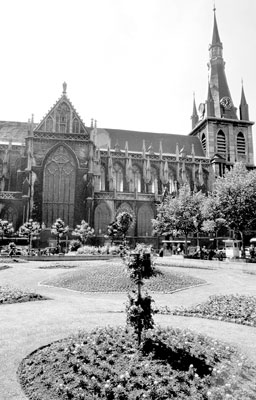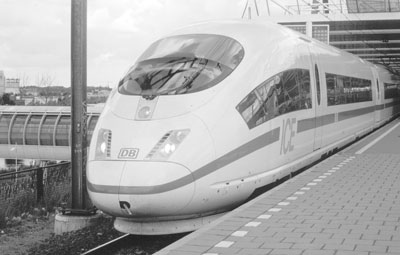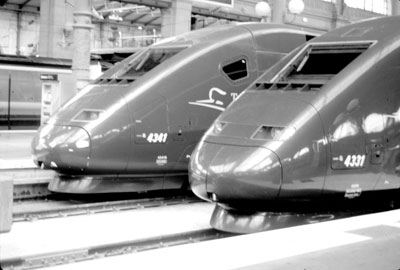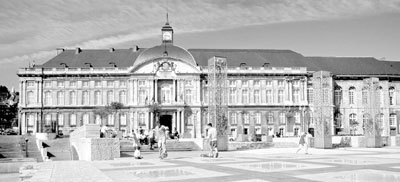New Belgian high speed
Prince Phillippe of Belgium inaugurated his nation’s second high-speed line on Dec. 10, 2002, between Leuven, 20 miles east of Brussels, and Liège in eastern Belgium near the German border.
The line, which was built to the same engineering standards as the high-speed line south to the French border, allows trains to run up to 186 mph and cuts 11 minutes from the Brussels-Liège timetable. Unfortunately, when it opened on Dec. 15 it was overshadowed by the simultaneous opening of the longer German high-speed line between Frankfurt and Cologne.
Taken by itself, the new 40-mile line would hardly be noticeable to passengers, but it is a piece of the larger picture that will reduce the time between Cologne and Paris from four to three hours by 2007 and will best air travel between the two cities.
Eastbound passengers depart Brussels’ South Station, pass through the tunnel below Brussels’ city center to the North Station and then continue to Leuven past the Zaventem Airport cutoff over double-tracked line, which soon will be quadrupled, with additional time savings of six minutes.
Shortly out of Leuven Station, which has been massively rebuilt with soaring arches over the platforms and escalators to the platforms, the train’s air-conditioning ceases and passengers coast without power while the driver changes from the usual Belgian 3000V DC electrical power to 25kV AC on the high-speed line. The ride on the high-speed line is as smooth as a shave on a razor blade commercial and travelers quickly arrive in Liège Guillemins Station.
From Liège Guillemins, a 150-mph line under construction for opening in 2006 will continue through a nearly 4-mile-long tunnel past Welkenraedt and connect to the 87-mph German line to Aachen.
Liège Guillemins Station
The new Liège Guillemins Station, 500 feet from Liège’s old station, will be astonishing, and no wonder: Santiago Calatrava, the preeminent railroad architect of the modern era and the man responsible for the stunning Lyon Airport train station and the amazing Lisbon Oriente Station, designed it.
Liège’s new Guillemins Station will have a gigantic steel-and-glass vault arching elegantly over the tracks to connect the district of the Cointe Hill to the Guillemins District. On the city side, the station will open on three levels linked together by escalators and elevators. On the Cointe Hill side, the station will be organized on five levels, including three levels of parking.
Belgium’s new line allows two scheduled high-speed trains to accelerate to 186 mph over this route. Using the line, multivoltage Thalys trains cut the time between Cologne and Paris, and GermanRail’s ICE3M trains blaze like lightning between Brussels, Frankfurt Airport and Frankfurt.
Thalys is a network of high-speed TGV trains. It connects Paris six times daily via Brussels, Liège and Aachen with Cologne Hbf and Cologne’s Deutz Station, which became the new terminus for Thalys after Düsseldorf service was discontinued. At Deutz you may change to the high-speed ICE trains to Frankfurt Airport, but allow seven minutes to change between Deutz’ upper and lower levels.
ICE 3M is an ICE 3 adapted for running on multiple power supplies. ICE 3s are the newest generation of high-speed and comfortable ICE trains that passengers can ride in Germany. These third-generation trains are rated at 205 mph maximum speed but run only up to 186 mph because they aren’t permitted to go full throttle.
ICE 3s are a complete break from the design of the earlier ICE trains because ICE 3’s design replaces the traditional locomotive with individually powered axles distributed beneath the passenger carriages, although the powered driving carriages do not have pantographs, which designers placed on intermediate carriages to permit roller-coaster running over the German high-speed line through the Taunus hills.
A third high-speed option is available to travelers to or from Liège by using the new Any Belgian Station fare between any station in Belgium and London aboard 186-mph Eurostar trains that pass through the Channel Tunnel between London and Brussels. From Liège, passengers pay no more than the simple Eurostar Brussels-London fare. From Brussels, travelers can reach London in a record two and a quarter hours using the nonstop 8:13 a.m. weekday departure.
More to come
Soon travelers will be able to ride an even more dramatic high-speed line under construction in segments between Brussels and Amsterdam, and they also will pass through the new high-speed level three of the completely rebuilt Antwerp Central Station and all-new stations in the Netherlands.
Both Thalys and ICE 3M honor Eurail products. ICE 3M trains also honor the German-Benelux 2-country railpass. Reservations are required for travel on Thalys and a supplement is payable on weekdays, when a meal is included. On weekends, no supplement is required and no meal is served. ICE 3M passengers do not require a reservation or pay a supplement.
I thank the Belgian Tourist Office (220 E. 42nd St., Ste. 3402, New York, NY 10017; phone 212/758-8130) for arranging accommodation at the 4-star Hotel Bedford (36, Quai St. Léonard, B-4000 Liège, Belgium), which has a lovely garden and overlooks the Meuse River. It is a convenient location for drivers speeding along the Quai St. Léonard outside and has free parking.
Rail Europe (phone 888/382-7245) provided my Eurail Flexipass, which I used to ride the ICE 3M.
In my next column, we’ll take a spectacular trip aboard the Mont Blanc Express through Chamonix, on the sunny side of the Alps.




